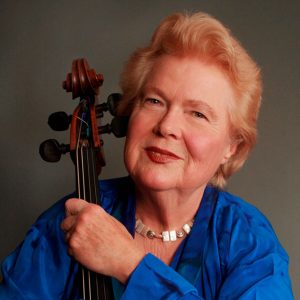
Searching For One’s Cello Voice
Bonnie Hampton
It is a remarkable thing that just as our vibratos show our individual expression, so ultimately does our “cello voice” as we develop our sound with the bow on the cello.
What are the elements which make up this search? It is a given that we can’t make a beautiful sound unless our bow arms are free and we are finding our energies all the way from the back, with none to the various joints or muscles adding physical tension or tightness. We need to have in our imagination, the qualities of sound we respond to. Perhaps we have heard a wonderful cellist who has inspired us, or perhaps there is a tone quality in our inner ear which we strive for. We are so fortunate, the cello is capable of producing the most radiant sounds, with every possible expression.
My own effort with any cello I play is first to try to find out how IT wants to be played. My habits with one cello don’t necessarily work with another instrument. I first go for the naturally resonant notes which have lots of overtones, such as the D on the A string, or the G on the D string. The low D on the C string is another good note. If we can work with the overtone ring of the sound that is a good start. Once one has found the natural and open sound, one can begin to find the same resonance on other notes.
We are in an age when we play in larger halls than might be really natural for the cello, so we push down to the bridge. However, my experience is that quality carries, and that the open vibration of the instrument is essential. We also need to support the sound so that it really comes out the F holes and has the clarity and ringing edge which will carry in the large halls.
Then we work for the vibrato to be in sync with the bow pressure and speed as another element of the equation. And lastly, or firstly, unless one is playing in tune, one can’t possibly find the overtone ring.
And what are all these efforts in the service of? We need every possible tonal color and intensity to bring to the service and needs of the music with its expressive and communicative message. I remember years ago hearing a very well known cellist (he is no longer alive) who started his concert with the Brahms E minor sonata with the most gorgeous warm beautiful sound. The only problem was that it went on with the same beautiful sound for the entire concert and it was just too much. This is a danger for us. The cello is such a wonderful instrument, but we need to find and use every one of its tonal possibilities.
My sense is that if one really wants to find ones individual “Voice” on the cello, one will. First of all, the desire to find it will definitely make one really listen to what is actually coming out. Yes, one might have to struggle, and learn to be patient, but it is there. Of course, it is an amazing experience to play a really great cello, but there are many very fine instruments which can produce wonderful sounds as well, if one just makes friends with them.
Subjects: Artistic Vision
Tags: Bonnie, bow speed, cello, cellobello, clarity, concert halls, expression, Habits, Hampton, imagination, individual voice, individuality, muscles, musicians, overtones, patience, performance, Sound, support, Teaching, tension, tone, vibrato
